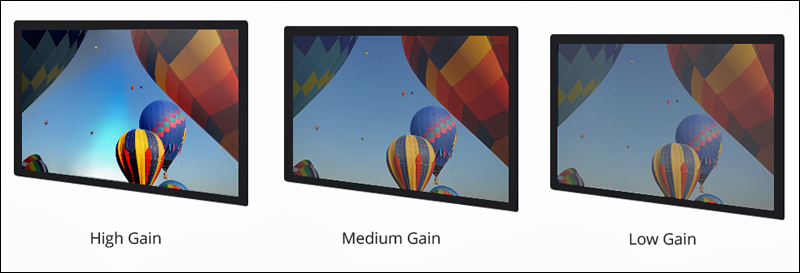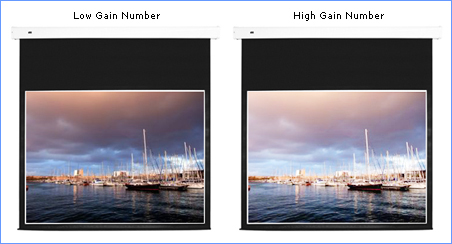Decoding Screen Gain in Projectors: A Comprehensive Guide
Introduction
Projectors have become essential tools for both personal entertainment and professional presentations. Yet, despite their prevalence, many people are still unfamiliar with a key parameter impacting their performance: screen gain. This comprehensive guide aims to clarify this concept, exploring its definition, measurement and role in overall image quality. By understanding screen gain, you can make an informed decision when purchasing your next projector and optimize your viewing experience.
What is a Screen Gain Projector?
Screen gain in projectors is a specification that's often overlooked, despite having a significant influence on the viewing experience. To help grasp the concept, let's dissect it into easily digestible elements:
- Meaning: Screen gain is an indicator of how reflective a projection screen is. It signifies how much light from a projector is 'amplified' or ‘bounced back' by the screen.
- Screen Gain Projector: A projector that utilizes a screen with a specified gain for image projection is referred to as a screen gain projector. The amplified light resulting from gain adds to the brightness of displayed images.
- Range: Gain values for screens usually span from 0.8 to 3.0. A gain of 1.0 is considered standard; it implies a screen reflects the same intensity of light as a standard white (magnesium oxide) board. Screen gain more than 1.0 means it reflects more light, thereby increasing brightness, while a value less than 1.0 will deliver dimmer visuals.
Understanding screen gain is the key to fine-tuning your projector's performance for the optimal viewing experience, be it for movies, presentations, or interactive displays.
How Is Screen Gain Measured in Projectors?
Screen gain, an essential property of projection screens, affects image brightness, viewing angles, and overall image quality. It is vital to understand its measurement process and the implications of varying gain values to make the best decisions for your projection needs.
Determining Screen Gain
Screen gain is quantified by comparing the volume of light reflected from the projection screen to the light emanation from a standard white (magnesium oxide) board. It uses a piece of equipment known as a reflectance meter.
Key aspects included in its measurement are:
• Zero-degree Viewing Angle: This is the most forward-pointing angle where the projector sits, providing the maximum screen gain.
• Viewing Angle Variation: As viewers move sideways from the zero-degree position, the light reflection and therefore gain decrease.
• Light Scattering and Hotspotting: These terms refer to uneven light projection. Screens that reflect light evenly everywhere have lower gain but provide a wider viewing angle and minimal hotspotting. On the contrary, screens reflecting most light directly forward have higher gain, a narrower viewing angle, and more hotspotting.
The Importance of Screen Gain Measurement
Understanding screen gain is vital due to its direct impact on several aspects of image display:
• Brightness: A higher gain results in a more vivid picture, while lower gain can cause images to appear dull.
• Viewing Angle: Gain determines the image's brightness for people viewing from different angles. Higher gain offers superior brightness for viewers directly in line with the screen, but those viewing at an angle might find the picture dimmer.
• Light Absorption: Higher gain leads to more light reflection and less absorption of the excessive light, and vice versa.
Overall, screen gain measurement helps strike a balance between brightness, viewing angle, and unwanted light absorption, crucial for determining image quality.
How Does Screen Gain Affect Image Quality?
The role of screen gain on the quality of images projected on a screen is profound and multifaceted. The ideal screen gain is crucial to envisioning the perfect movie night or delivering effective presentations. Here's a concise overview of how screen gain can impact your viewing experience:
1. Brightness and Contrast: A key factor influenced by screen gain is the brightness of the projected image. High-gain screens can notably amplify the light for a brighter picture. Conversely, low-gain screens produce a softer brightness but often deliver better contrast, enabling the viewer to distinguish subtle differences in shades and colors.
2. Viewing Angle: The screen gain also affects the viewing angle. Higher gain screens provide a vibrant picture for viewers seated directly inline but may compromise on the brightness for off-center viewers. Low gain screens, on the other hand, offer consistent brightness for viewers across wider angles.
3. Color Accuracy: The choice of screen gain can also impact the fidelity of color reproduction. High gain screens might occasionally distort colors, especially at wider viewing angles. In contrast, low gain screens are known to present colors more accurately and consistently across all viewing angles.
4. Hotspotting: High-gain screens come with an increased risk of hotspotting, where the center of the screen appears disproportionately brighter than the edges. Such situations may distract viewers and disrupt their engagement with the content.
The appropriate screen gain vastly depends on your specific needs and viewing circumstances. Therefore, understanding these factors will enable you to choose the right balance and get the most out of your visual experience.
Comparing High Gain and Low Gain Screens: Which Should You Choose?
When choosing between high gain and low gain screens, it's essential to understand their differences, advantages, and drawbacks. Here’s a comparative analysis to help you make an informed decision:
High Gain Screens – A Closer Look
High gain screens possess gain values greater than 1.0 and are known for their heightened reflectivity. Key characteristics include:
- Brightness: High gain screens are able to reflect more light, resulting in a brighter and more vivid image. This makes them particularly effective in environments with high ambient light or for projectors with low brightness.
- Viewing Angle: These screens tend to have a narrower viewing angle, favoring viewers directly in front of the screen. The brightness tends to decrease for those viewing at oblique angles.
- Hotspotting: The high light reflectivity can occasionally lead to a problem known as hotspotting, where the center of the screen appears brighter than the edges.
- Color Accuracy: High-gain screens may also slightly distort color accuracy and suppress deeper black tones.
Low Gain Screens – Advantages and Drawbacks
Low gain screens, on the other hand, have gain values less than 1.0 and offer a different set of characteristics:

- Light Diffusion: Low gain screens deliver softer, diffused light, offering a more uniform image across the screen.
- Room Setting: These screens are generally preferred in dark rooms or with high-luminosity projectors as they reflect less light, which can result in a dimmer image in a brighter environment.
- Viewing Angle: They provide wider viewing angles, delivering a balanced image for viewers spread across different directions.
- Color Accuracy: Unlike high-gain screens, low gain screens are renowned for facilitating authentic colors and deeper blacks, enriching the viewing experience.
In conclusion, your choice between high gain and low gain screens would primarily depend on your specific requirements - the room's lighting conditions, the projector's brightness, and the seating arrangement. It’s about striking the right balance for the optimal viewing experience.

Conclusion
Choosing between a high gain and low gain screen largely depends on your room conditions, projector specifications, and viewing requirements. High gain screens, with a gain value above 1.0, are best for environments with high ambient light or projectors with low brightness. They reflect more light directly forward, leading to brighter images, but may cause hotspotting and exhibit a narrower viewing angle. They favor viewers seated directly in front of the screen.
On the other hand, low gain screens, with a gain value below 1.0, are generally best for dark rooms and projectors with high luminosity. They can deliver a uniformly lit, softer image, ideal for wide viewing angles, but may come off as too dim in rooms with ambient light. For true color reproduction and deep black levels, a low gain screen would be the ultimate choice.
Essentially, your selection hinges on the concert of your projector's brightness, the light condition of the room, and the viewers' seat arrangement.
Related FAQs about what is screen gain projector
How different would a movie experience be on High Gain vs Low Gain Screens?
High Gain screens tend to produce vibrant, bright images, ideal for environments with high ambient light or low-luminosity projectors. However, they also have a narrower viewing angle, likely leading to hotspotting. Low Gain screens, on the other hand, are preferred for darker rooms, providing consistent brightness across wider viewing angles and portraying more accurate colors.
Can Screen Gain in Projectors be Adjusted?
No, screen gain is not something that can be adjusted in a projector. It's a property of the projector screen itself, depending on the type of materials used and the manufacturing process. Selection of the appropriate screen gain will need to be determined at the time of purchase.
How is Screen Gain related to Projector Brightness?
Screen gain and projector brightness closely interrelate - gain refers to the screen's reflectivity or how much light from the projector it bounces back. A high gain will result in a brighter image, effective for projectors with low brightness or rooms with high ambient light. Conversely, a high-luminosity projector matched with a low-gain screen could strike an ideal balance.


